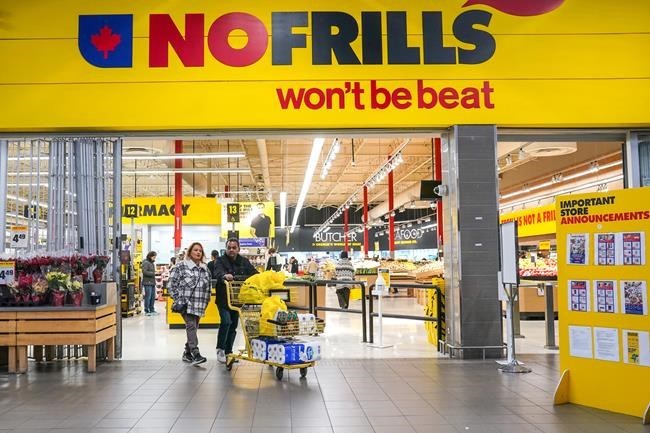As the cost of living rises, you may be cutting back on dining out or ordering in.
But it’s not as simple as just cooking more often at home. Meal planning can be overwhelming if you're new to it, and groceries aren’t exactly cheap, either, as the prices of many everyday staples have been hit by inflation.
“It doesn’t have to be all or nothing,” advises Alex MacLaren.
As a content creator who posts about budget-friendly cooking, MacLaren is well versed in savvy shopping and using up the food she has. But she says it’s important to make sustainable changes when looking to save money.
“You don't have to start as an expert. Start as a beginner.”
Financial planner Janet Gray suggests starting by setting a budget for groceries that doesn't eat into your other financial obligations, like bills and rent.
If you find yourself consistently overspending on food, you can try buying grocery gift cards or using cash at the checkout to help you stay below your limit, she said.
But don’t make the budget too restrictive, or you’ll have a harder time sticking to it, warns Jesi Lopez, the owner of Simple Frugal Basic, a resource for Canadians looking to save on household essentials and learn about effectively managing a household.
While you should leave your appetite at home, what you do need to bring to the grocery store is a plan.
MacLaren, Gray and Lopez agree you should assess what you have at home before making your shopping list.
MacLaren bases her meal plans partially on what she needs to use and what’s on sale, as well as what’s in the freezer. But she also plans meals that she’s been craving.
“It's more sustainable long-term if you're not always depriving yourself,” she said.
Lopez recommends setting aside time to go through weekly grocery flyers, which she does on an app called Flipp.
You should keep an eye out for your regular staples in the flyers, she said, so you can pick them up at a discount.
Picking out flyer deals doesn’t mean you have to drive around town going to multiple stores, noted Lopez. If you go to a store that price-matches, you should be able to get all those deals you've picked out in one place.
Apps like Too Good To Go or Flashfood, which connect customers with surplus food from restaurants and stores, are good ways to get discounted meat, she added.
While it might take some time to find what you’re looking for on those apps, “even if you get one good score a month, you’re able to stock your freezer,” said Lopez.
While at the grocery store, check out the discount racks or look out for items marked down because they’re nearing their best-before dates, said Gray. And if you’re easily tempted, try avoiding the aisles you don’t need to go down.
“If you have a list, you're kind of laser-pointed,” she said.
If you’re following a recipe and don’t have all the ingredients, resist the temptation to go out and buy everything, MacLaren said. Instead, look for substitutions for ingredients that you know you won’t use often.
To minimize food waste, Lopez recommends keeping multi-functional food staples in the house, and learning to preserve or freeze extras.
It’s important to find a routine that works for you, Lopez said — some people plan their meals more generally while others prep ahead of time, for example. She makes sure her weekly plans include entertaining and eating out, and buys groceries for breakfast and lunch that everyone in the family can easily use to fix their own meals.
If you’re still figuring out how to cook for yourself more often, don’t feel pressured to make everything from scratch, MacLaren said — there’s nothing wrong with pre-packaged ingredients that you can jazz up with vegetables or meat.
It’s also good to keep some “convenience foods” around, said MacLaren, whether that’s boxed macaroni and cheese or a frozen pizza. When you’ve got no time or no energy to cook, these options will be much cheaper than ordering in, she said.
As you get accustomed to cooking more at home, there are some staples that are cheaper to make at home than buy, said MacLaren. These include salad dressings, spice blends, bread (if you have the time), and shredded cheese (save money by shredding it yourself).
But as always, you have to weigh saving money with convenience and time, she said. If making something from scratch is a barrier to eating at home, then the more convenient option may be the better one for you.
“You don’t want to feel restricted,” she said.
If you regularly use loyalty programs, Gray cautioned against buying items you wouldn’t have bought otherwise because of a points deal.
“Be conscious of the incentive to spend more to save more,” she said.
Lopez is a big collector of loyalty and credit card points, though she doesn’t use every single rewards app out there, instead sticking to the most rewarding ones.
For several years, she’s planned two no-spend months per year where she only uses her accumulated points and stockpiled food. It helps her declutter her pantry and save some extra money.
Putting more time into planning your grocery shopping and trying to save money wherever you can has benefits beyond cost savings, said Lopez — it’s something the whole family can work on together, and it can help model fiscal responsibility for your kids.
“It does require a bit of work, but the balance is what will help you in the long run.”
This report by The Canadian Press was first published Jan. 25, 2024.
Rosa Saba, The Canadian Press



